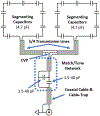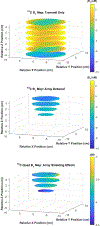A 16-Channel 13C Array Coil for Magnetic Resonance Spectroscopy of the Breast at 7T
- PMID: 33651680
- PMCID: PMC8281383
- DOI: 10.1109/TBME.2021.3063061
A 16-Channel 13C Array Coil for Magnetic Resonance Spectroscopy of the Breast at 7T
Abstract
Objective: Considering the reported elevation of ω-6/ω-3 fatty acid ratios in breast neoplasms, one particularly important application of 13C MRS could be in more fully understanding the breast lipidome's relationship to breast cancer incidence. However, the low natural abundance and gyromagnetic ratio of the 13C isotope lead to detection sensitivity challenges. Previous 13C MRS studies have relied on the use of small surface coils with limited field-of-view and shallow penetration depths to achieve adequate signal-to-noise ratio (SNR), and the use of receive array coils is still mostly unexplored.
Methods: This work presents a unilateral breast 16-channel 13C array coil and interfacing hardware designed to retain the surface sensitivity of a single small loop coil while improving penetration depth and extending the field-of-view over the entire breast at 7T. The coil was characterized through bench measurements and phantom 13C spectroscopy experiments.
Results: Bench measurements showed receive coil matching better than -17 dB and average preamplifier decoupling of 16.2 dB with no evident peak splitting. Phantom MRS studies show better than a three-fold increase in average SNR over the entirety of the breast region compared to volume coil reception alone as well as an ability for individual array elements to be used for coarse metabolite localization without the use of single-voxel or spectroscopic imaging methods.
Conclusion: Our current study has shown the benefits of the array. Future in vivo lipidomics studies can be pursued.
Significance: Development of the 16-channel breast array coil opens possibilities of in vivo lipidomics studies to elucidate the link between breast cancer incidence and lipid metabolics.
Figures







Similar articles
-
Effects of proximity and noise level of phased array coil elements on overall signal-to-noise in parallel MR spectroscopy.Magn Reson Imaging. 2018 Apr;47:125-130. doi: 10.1016/j.mri.2017.12.001. Epub 2017 Dec 5. Magn Reson Imaging. 2018. PMID: 29217493 Free PMC article.
-
A 32-channel receive array coil for bilateral breast imaging and spectroscopy at 7T.Magn Reson Med. 2021 Jan;85(1):551-559. doi: 10.1002/mrm.28425. Epub 2020 Aug 9. Magn Reson Med. 2021. PMID: 32820540 Free PMC article.
-
A flexible 8.5 MHz litz wire receive array for field-cycling imaging.Phys Med Biol. 2023 Feb 27;68(5). doi: 10.1088/1361-6560/acb9d0. Phys Med Biol. 2023. PMID: 36750000
-
An endovaginal MRI array with a forward-looking coil for advanced gynecological cancer brachytherapy procedures: Design and initial results.Med Phys. 2021 Nov;48(11):7283-7298. doi: 10.1002/mp.15228. Epub 2021 Oct 8. Med Phys. 2021. PMID: 34520574 Free PMC article.
-
A birdcage transmit, 24-channel conformal receive array coil for sensitive 31P magnetic resonance spectroscopic imaging of the human brain at 7 T.NMR Biomed. 2024 Oct;37(10):e5178. doi: 10.1002/nbm.5178. Epub 2024 May 24. NMR Biomed. 2024. PMID: 38784970
Cited by
-
Signaling pathways in cancer metabolism: mechanisms and therapeutic targets.Signal Transduct Target Ther. 2023 May 10;8(1):196. doi: 10.1038/s41392-023-01442-3. Signal Transduct Target Ther. 2023. PMID: 37164974 Free PMC article. Review.
-
Dual-Tuned Lattice Balun for Multi-Nuclear MRI and MRS.IEEE Trans Med Imaging. 2022 Jun;41(6):1420-1430. doi: 10.1109/TMI.2022.3140717. Epub 2022 Jun 1. IEEE Trans Med Imaging. 2022. PMID: 34990352 Free PMC article.
References
-
- Bray F, et al., Global cancer statistics 2018: GLOBOCAN estimates of incidence and mortality worldwide for 36 cancers in 185 countries. Ca-a Cancer Journal for Clinicians, 2018. 68(6): p. 394–424. - PubMed
-
- DeSantis CE, et al., Breast cancer statistics, 2017, racial disparity in mortality by state. CA - A Cancer Journal for Clinicians, 2017. 67(6): p. 439–448. - PubMed
-
- Ferlay J, et al., Estimates of worldwide burden of cancer in 2008: GLOBOCAN 2008. International Journal of Cancer, 2010. 127(12):p. 2893–2917. - PubMed
-
- Kolonel LN, Altshuler D, and Henderson BE,The multiethnic cohort study: Exploring genes, lifestyle and cancer risk. Nature Reviews Cancer, 2004. 4(7): p. 519–527. - PubMed
-
- Armstrong B and Doll R,Environmental Factors and Cancer Incidence and Mortality in Different Countries, with Special Reference to Dietary Practices. International Journal of Cancer, 1975. 15(4): p. 617–631. - PubMed
Publication types
MeSH terms
Grants and funding
LinkOut - more resources
Full Text Sources
Other Literature Sources
Medical
Miscellaneous

